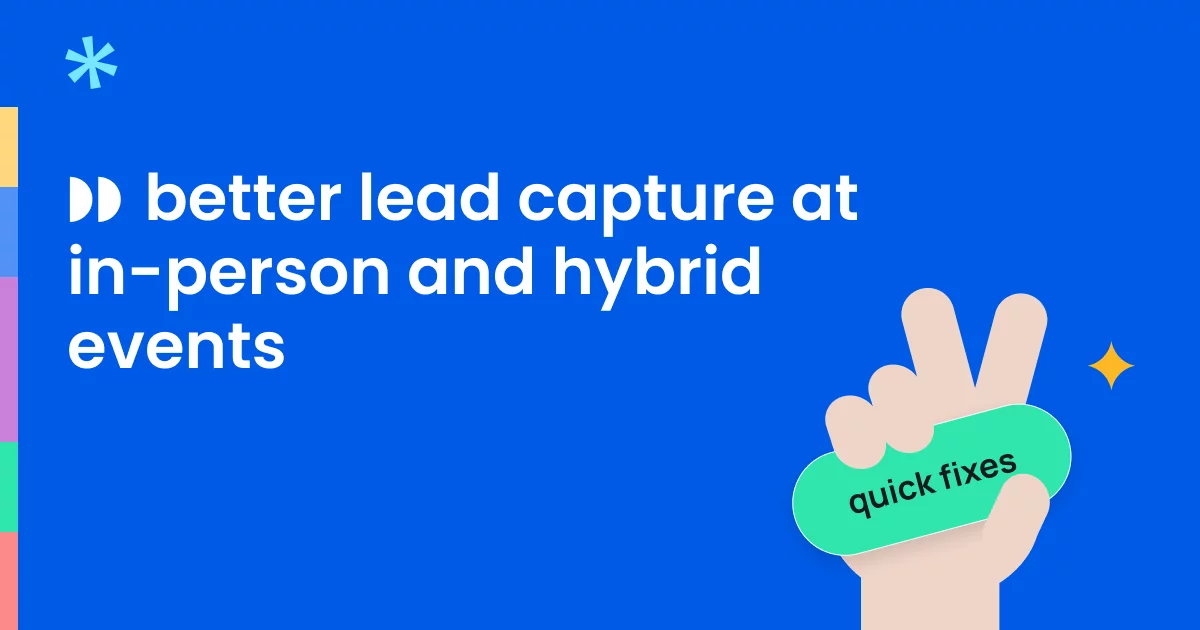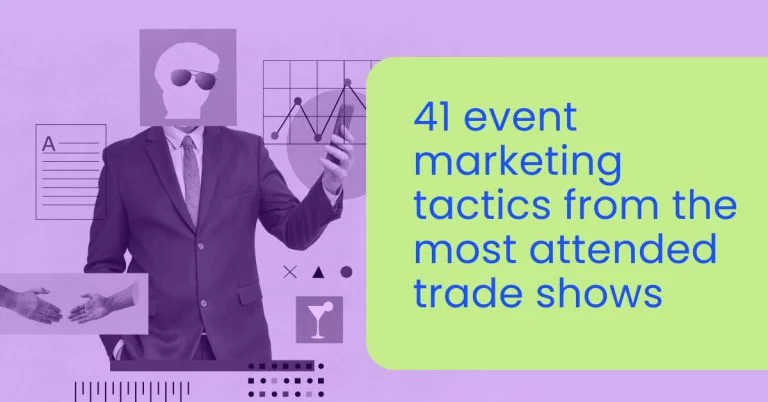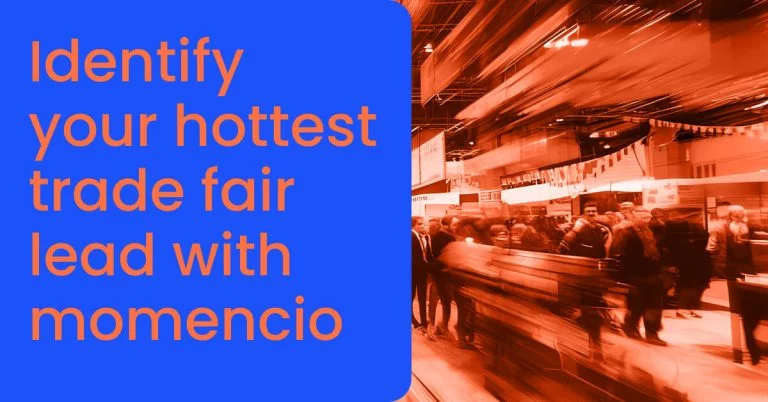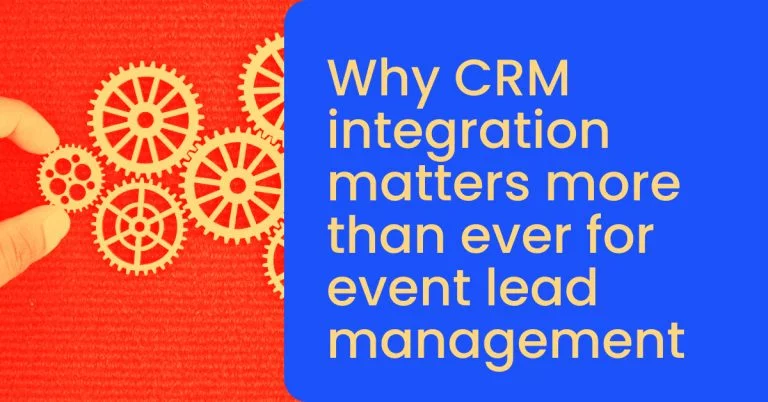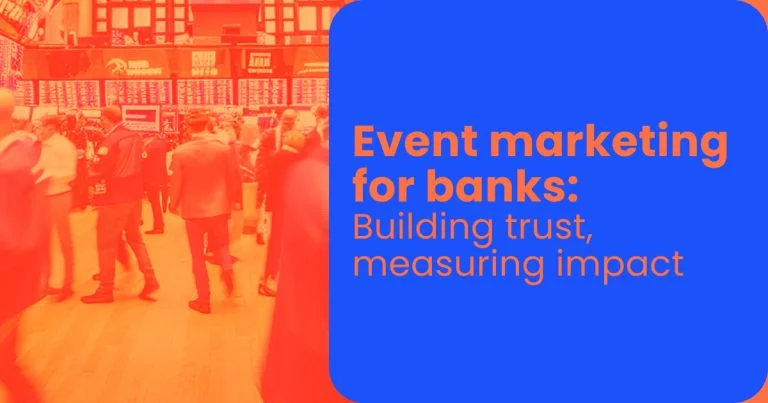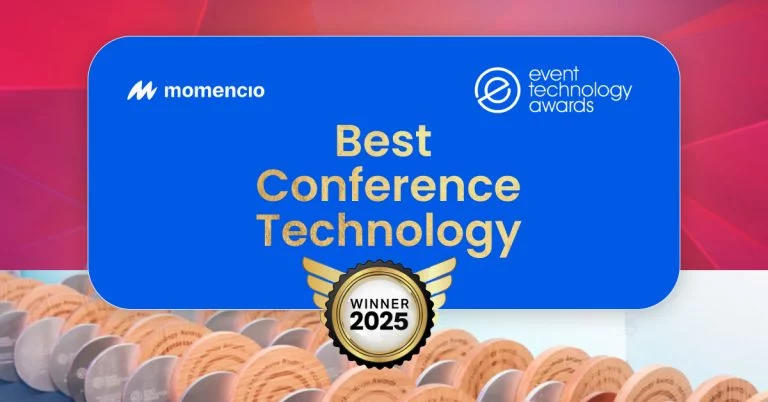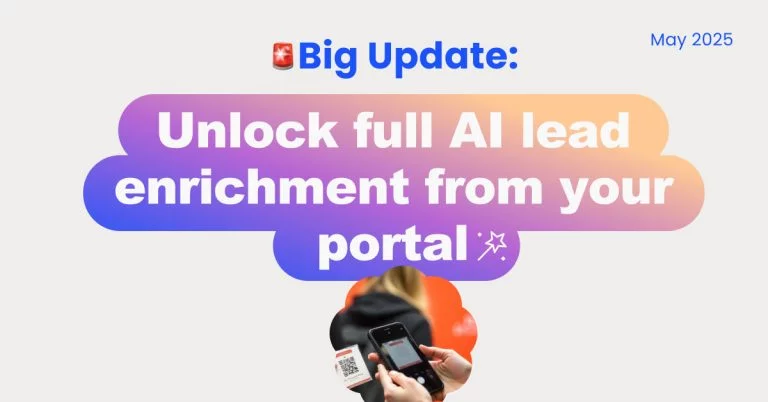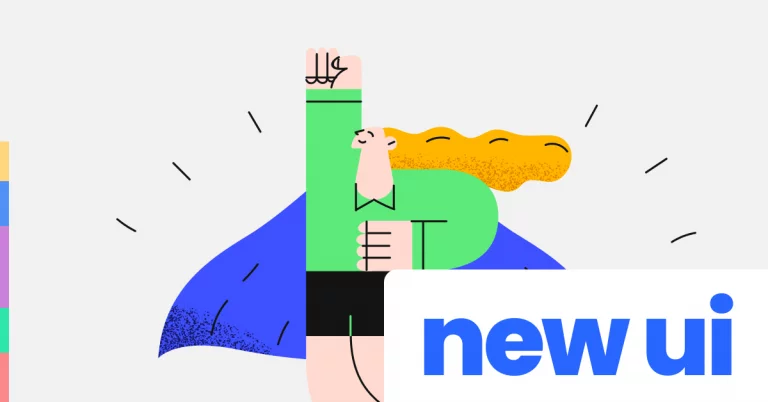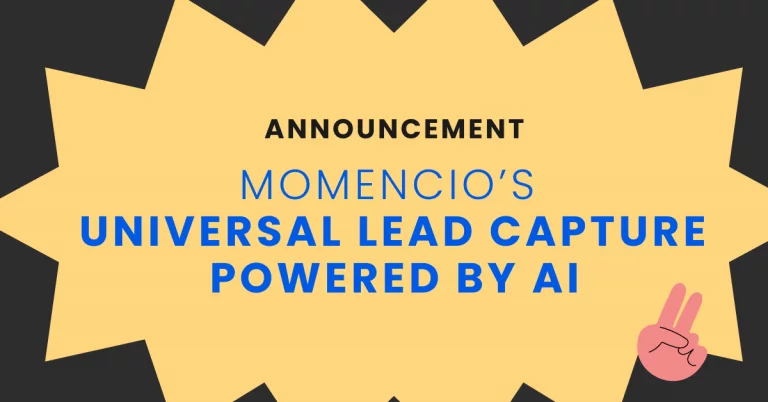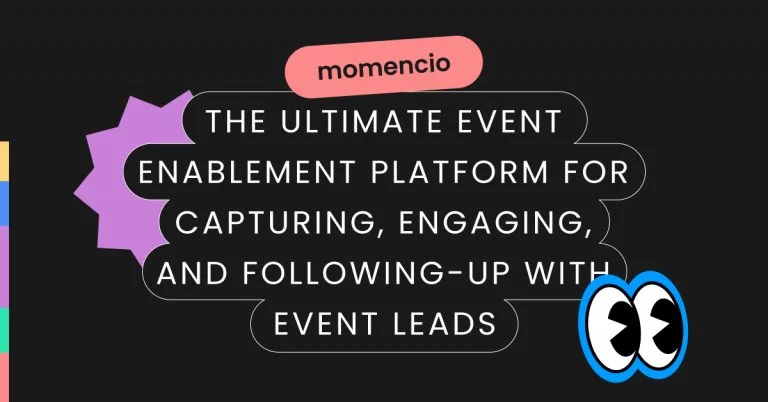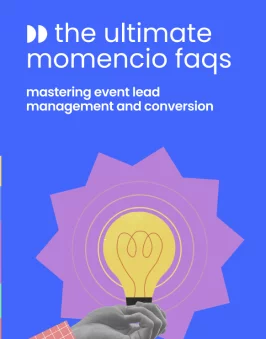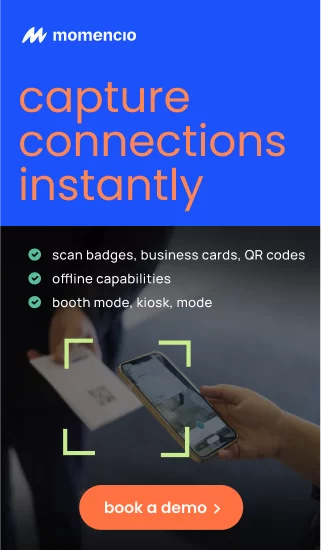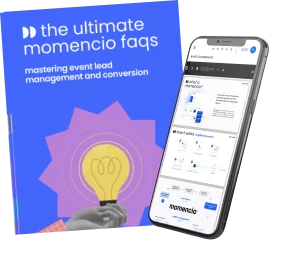Lead capture can make or break your success at a trade show or hybrid event. You spend weeks preparing for the big day, but when it comes to turning conversations into actionable leads, things fall apart. Missed data, slow syncing, and disorganized follow-ups can cost you heavily.
You are not alone. These problems happen to exhibitors all the time. And every lead you lose is an opportunity slipping through your fingers. The good news? Fixing these issues is easier than you think.
This guide will show you simple, quick fixes that ensure your lead capture works flawlessly—whether you are at a bustling trade show or managing a hybrid event. No over-complicated tech. Just actionable tips you can implement now to capture every lead, streamline follow-ups, and increase your chances of closing deals.
Ready to fix your lead capture problems? Let’s dive into the solutions.
Common lead capture issues faced by exhibitors
Most exhibitors experience lead capture issues during events, but the problem often goes unnoticed until it is too late. Lost leads, incomplete data, or chaotic follow-up processes can derail your post-event efforts and hurt your ROI. Here are the most common lead capture problems exhibitors face—and the quick fixes to solve them.
Missed leads due to inefficient systems
You are chatting with a prospect at your booth, making a connection. The conversation is going well. Then, you scramble for a badge scanner or fumble with business cards, losing momentum. By the time you find the right tool, the moment is gone—and so is the lead.
This happens more often than you think. Relying on clunky or outdated systems is one of the biggest reasons exhibitors miss leads at trade shows. Fixing this is simple: streamline your tools. Use mobile apps that instantly scan badges or business cards and sync the data to your CRM. Tools that let you log notes on the spot are even better—they make follow-up much easier and more personal.
In short, make sure your system is quick, easy to use, and integrated. A frictionless lead capture tool lets you focus on the conversation, not the tech.
Check out momencio’s features for seamless lead capture.
Data delays slowing down follow-up
Timing is everything when it comes to following up with leads. After an event, attendees quickly move on. If your lead data is not ready to go immediately, you lose valuable time. Delays in syncing data across different devices or platforms are a major culprit here.
The fix? Ensure real-time data syncing. Invest in lead capture systems that automatically upload information to your CRM, so your sales team can access it instantly—no manual transfer needed. Whether the lead visited your booth in person or attended virtually, your follow-up can start while the event is still fresh in their mind.
By removing data bottlenecks, you can act faster than your competitors. It is as simple as choosing the right tools and workflows that prioritize real-time synchronization.
Low-quality lead data impacting follow-up
Let us be honest: a name and email address are not enough to make a meaningful connection after an event. Many exhibitors gather leads but lack the context needed to personalize follow-ups. If your follow-up feels generic, your chances of converting that lead drop dramatically.
The solution is capturing more context upfront. Use tools that allow you to add notes about conversations, attendee interests, or product demos they interacted with. Surveys or engagement quizzes at your booth can also help qualify leads on the spot, giving you better information to work with after the event.
Check out momencio’s AI lead enrichment feature
Capturing detailed lead information makes personalization much easier, leading to stronger, more effective follow-up emails. Tools that integrate lead scoring can help prioritize your hottest leads, so you know where to focus first.
Best practices to improve lead capture during events
Fixing common issues is only part of the battle. To truly level up your lead capture game, you need to optimize the entire process—from first contact to follow-up. Here are some best practices that will ensure you are not just capturing leads but also setting the stage for better conversions.
Use the right tools for the job
Not all lead capture tools are created equal. At a busy trade show or during a hybrid event, you need tools that make the process as seamless as possible. Badge scanners, mobile apps, and digital forms should all be part of your setup, but the key is making sure they work together. You do not want to juggle five different systems that do not talk to each other.
Choose an integrated platform that captures data quickly and syncs it to your CRM. Tools that allow real-time data transfer are crucial for effective follow-up. This way, the leads you capture are immediately actionable by your sales team.
Engage attendees in meaningful ways
Lead capture is not just about collecting contact info—it is about building a connection. Use engaging booth experiences like interactive product demos, gamification, or surveys to pull in visitors and learn more about their specific interests.
The more personalized the engagement, the more likely they will remember your brand when you follow up after the event. Gamification and quizzes can also qualify leads on the spot, which helps you prioritize follow-up efforts more effectively.
Focus on real-time insights
Capturing leads during an event is one thing; knowing what to do with them is another. Real-time insights can give you a major edge by telling you how attendees are interacting with your booth or virtual platform. Are they spending time on a specific product demo? Are they opening your emails?
Use these real-time insights to tailor your engagement on the spot. If a prospect shows interest in a specific feature, have a sales team member ready to jump in and offer more details. Real-time data helps you act fast and offer a more personalized experience while the event is still happening.
Maximizing post-event follow-ups for better conversions
You have captured the leads. Now what? Most exhibitors drop the ball in the follow-up stage, and that is where they lose valuable business. Here is the thing—post-event follow-ups should not feel like an afterthought. They are as crucial as your presence at the event.
The timing problem
Waiting too long to follow up is a common mistake. Every minute that passes after the event is time lost in solidifying that connection. Leads cool down fast. And by the time you send that generic “Thanks for stopping by” email, they have probably forgotten who you are. Or worse, they have already moved on to your competitor.
Quick fix: Follow up immediately. Not tomorrow, not next week. Right after the event. Use tools that allow you to trigger personalized emails automatically as soon as the lead data is captured. This simple move can keep your brand fresh in their mind and make your follow-up feel more personal.
Personalization—your secret weapon
Here is another misstep exhibitors often make: sending the same cookie-cutter email to every lead. If it does not speak directly to what the prospect cared about during the event, it is going to get ignored. Think about it: you spend time engaging with these leads in person (or virtually), and then you send an email that could have been written by a bot. It makes no sense.
Quick fix: Personalize every interaction. Pull insights from the conversation you had or the product demo they seemed interested in. Your follow-up email should not feel like a generic touchpoint. Instead, it should build on the momentum you created during the event. Reference specific things from your chat, address their pain points, and guide them to the next logical step in their buyer’s journey.
Nurture leads, do not push for the sale
Another mistake? Being too pushy in your follow-ups. After the event, your goal should not be to close the deal on the first email. Leads need time to nurture. Bombarding them with aggressive sales tactics can scare them off.
Quick fix: Take a gentler approach. Instead of focusing on immediate sales, use your follow-up emails to add value. Share helpful resources, answer questions they had at the event, or invite them to a demo of your product. This shows them you are interested in building a relationship, not just closing a deal.
Nurturing takes time, but it pays off in long-term conversions.
Following up on multiple channels
Here is something people do not talk about enough: Your follow-up does not have to stop at email. Why limit yourself to one channel? Social media, phone calls, and even personalized landing pages give you more ways to stay top of mind with your leads.
Quick fix: Start by sending a follow-up email, but do not stop there. Connect on LinkedIn. Share relevant content via social platforms. Or, even better, create a personalized microsite for your lead. A microsite can showcase the specific products or solutions they expressed interest in, making your follow-up hyper-relevant.
Leveraging real-time insights for immediate action
Imagine this: You are halfway through a major trade show, and your team is collecting leads. You might be getting a steady flow of foot traffic to your booth or engaging with virtual attendees, but how do you know which leads are worth prioritizing right now? Are they genuinely interested in your offerings, or are they just browsing?
This is where real-time insights become a game-changer.
The real-time advantage
Collecting leads is just the first step. To get the most out of your event, you need to adjust your approach on the fly—while the event is still happening. Relying solely on post-event analysis means you are missing opportunities to act in the moment. Real-time data shows you who is engaging with your booth, what products or services they are interested in, and how much time they are spending on each interaction.
Quick fix: Use real-time data to shape your event strategy as the day unfolds. With the right tools, like live analytics dashboards, you can track attendee behavior instantly. Notice a spike in interest around a particular product? Assign a team member to focus on that. See someone hovering around your booth but not engaging? Send someone over to spark a conversation.
Gamification and engagement techniques
Want to know a secret to keeping attendees engaged? Gamification. It is not just a buzzword—it works. Games, quizzes, or interactive challenges draw people in and keep them around long enough to make a meaningful connection. Better yet, gamification helps you gather more insights about what interests your attendees, all while they are having fun.
Quick fix: Use gamification to capture more detailed lead data. You can create a simple trivia game around your product or service that encourages attendees to participate. As they play, you collect information about their interests and engagement levels—valuable data you can use for post-event follow-ups. It also gives you a chance to build rapport in a relaxed setting, increasing the chances of a lead remembering you.
If you want to know more about the power of gamification in events, check out momencio’s article on using interactive engagement strategies to enhance lead capture.
Tracking virtual and in-person attendees
Hybrid events bring another layer of complexity: You are managing both in-person and virtual attendees at the same time. The challenge here is making sure you are capturing high-quality leads from both sides without missing a beat. Virtual attendees might engage differently than those in person, so you need to track behaviors across multiple channels—whether they are visiting your booth physically or interacting with your virtual platform.
Quick fix: Choose a platform that offers unified insights for both in-person and virtual attendees, allowing your team to track lead behavior across all channels in real-time. This way, you are not missing opportunities to engage with a promising lead just because they attended virtually. Keep an eye on how long attendees stay in your booth, which content they interact with, and how engaged they seem.
#DidYouKnow – 36% of marketers find it challenging to track leads generated from form submissions.
For more strategies on managing hybrid event leads effectively, explore momencio’s hybrid event optimization tips to ensure your lead capture processes are in sync.
Hybrid event solutions: Capturing leads in both physical and virtual settings
Hybrid events are the new frontier, and with them comes the challenge of balancing two worlds: the live, in-person interactions and the digital experiences happening simultaneously. Managing lead capture for both environments presents unique obstacles, but with the right strategy, you can turn this challenge into an advantage.
Blending the physical and digital worlds
Capturing leads at hybrid events requires a solution that does not just treat physical and virtual leads as separate entities. You need a holistic view of your prospects. Whether an attendee stops by your physical booth, joins a virtual session, or downloads a resource online, the experience should feel consistent and unified.
Quick fix: Use hybrid-friendly lead capture tools that can handle multiple touchpoints. For example, a platform that allows you to scan badges in person while also tracking virtual behaviors—like when attendees visit your virtual booth or engage with online content. This ensures you have a complete profile of each lead, no matter where or how they interact with you.
Engaging both audiences simultaneously
Hybrid events present a unique opportunity to engage two different types of attendees in real time. But here is the trick: you cannot treat them the same. Virtual attendees require different engagement tactics than in-person attendees. They might prefer instant access to content, while in-person attendees might want more hands-on experiences.
Quick fix: Tailor your engagement for each audience. For virtual attendees, provide easy access to digital resources, live demos, or chat support. For in-person attendees, focus on personalized interactions and physical product demos. However, the key is ensuring both groups feel like they are part of a unified experience—regardless of whether they are interacting with you in person or online.
Conclusion
Lead capture does not have to be complicated or overwhelming. By addressing common challenges—like inefficient systems, delayed data syncing, and lack of personalization—you can turn your event presence into a lead-generation powerhouse. The quick fixes we have covered—such as implementing the right tools, using real-time insights, and personalizing follow-ups—will help you streamline your process and capture higher-quality leads.
Whether you are managing an in-person trade show booth or running a hybrid event, optimizing your lead capture can be the difference between missed opportunities and lasting business relationships. By focusing on efficiency, personalization, and using the right technology, you can ensure that every lead counts.
FAQs
- How quickly should I follow up with leads after an event?
- The best time to follow up is within 24 hours after the event. The sooner you reach out, the more likely the prospect is to remember your conversation and stay engaged. Using an automated follow-up system that sends personalized emails immediately can make this process seamless.
- What are the best tools for lead capture at hybrid events?
- For hybrid events, it is crucial to have a platform that integrates both in-person badge scanning and virtual engagement tracking. You need a system that works across different environments without missing any touchpoints. Tools that sync with your CRM and offer real-time data are ideal.
- How can I ensure I am capturing high-quality leads?
- Quality comes from understanding your audience and capturing relevant information beyond just contact details. Use surveys, ask specific questions, or take notes during conversations to capture key details that will help you personalize your follow-ups. Additionally, integrating lead scoring helps prioritize leads based on their behavior and engagement.
- How do I keep leads warm after the event?
- The key to keeping leads warm is consistent, personalized communication. Do not wait for weeks after the event to reach out. Instead, provide valuable content, follow up with personalized emails, and consider offering webinars or product demos to maintain engagement.
- What is the most common mistake exhibitors make with lead capture?
- The biggest mistake is not using a unified system for lead capture, which leads to fragmented data and missed opportunities. When your tools are not connected, it becomes difficult to follow up promptly or personalize your outreach effectively. Use an integrated platform that syncs all your lead data in real-time for the best results.
